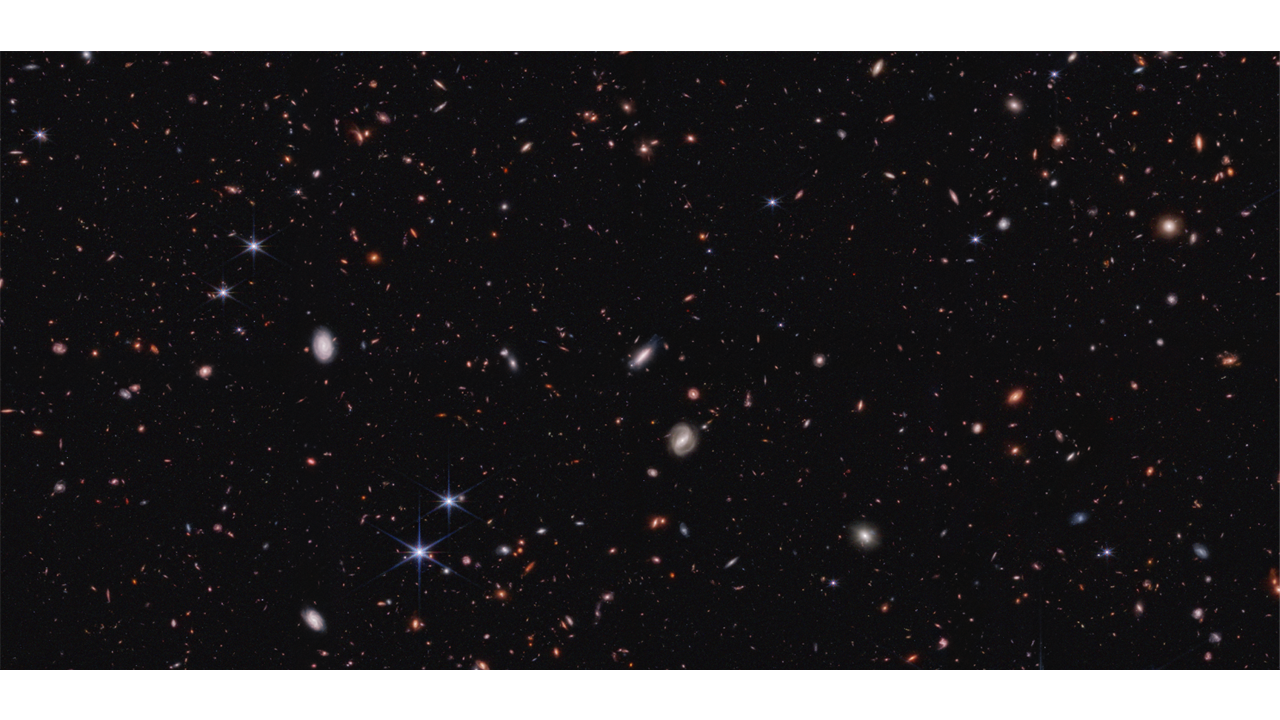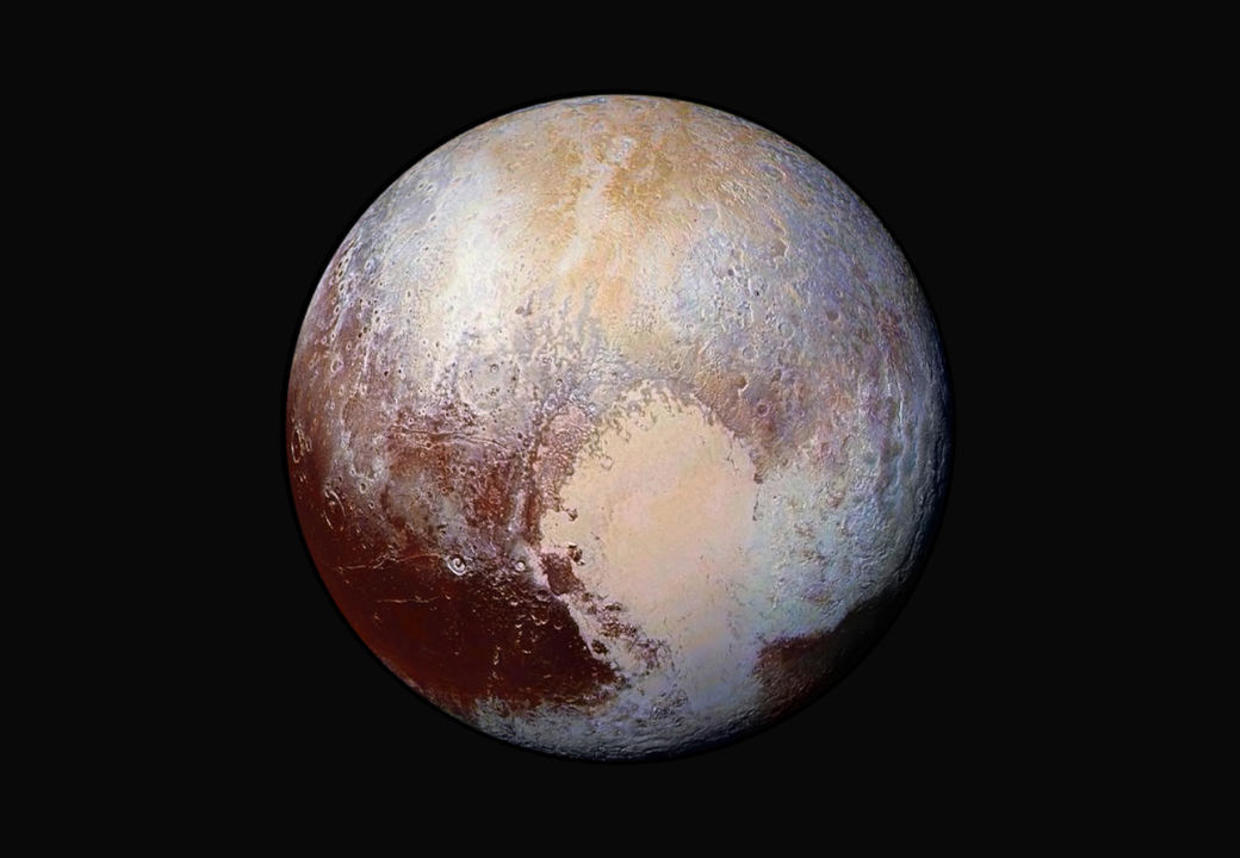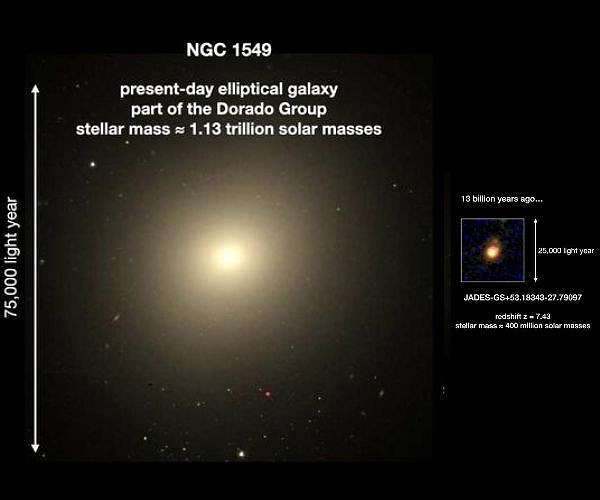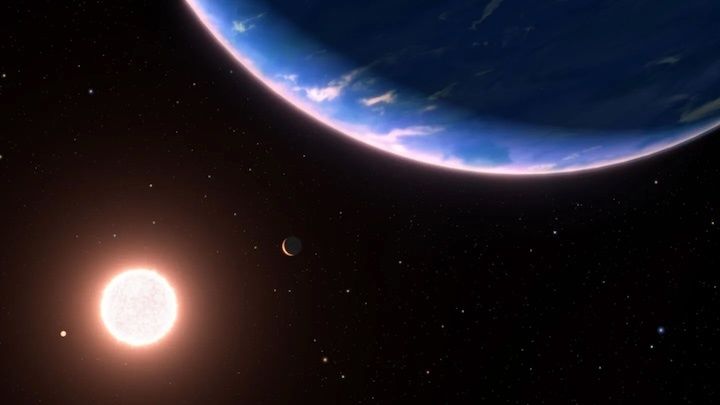It’s 7 billion years ago, and the universe’s heyday of star formation is beginning to slow. What might our Milky Way galaxy have looked like at that time? Astronomers using NASA’s James Webb Space Telescope have found clues in the form of a cosmic question mark, the result of a rare alignment across light-years of space.
1.09.2024
Webb Finds Early Galaxies Weren't Too Big for Their Britches After All

When astronomers got their first glimpses of galaxies in the early universe from NASA's James Webb Space Telescope, they were expecting to find galactic pipsqueaks, but instead they found what appeared to be a bevy of Olympic bodybuilders. Some galaxies appeared to have grown so massive, so quickly, that simulations couldn’t account for them. Some researchers suggested this meant that something might be wrong with the theory that explains what the universe is made of and how it has evolved since the big bang, known as the standard model of cosmology.
According to a new study in the Astronomical Journal led by University of Texas at Austin graduate student Katherine Chworowsky, some of those early galaxies are in fact much less massive than they first appeared. Black holes in some of these galaxies make them appear much brighter and bigger than they really are.
“We are still seeing more galaxies than predicted, although none of them are so massive that they ‘break’ the universe,” Chworowsky said.
The evidence was provided by Webb’s Cosmic Evolution Early Release Science (CEERS) Survey, led by Steven Finkelstein, a professor of astronomy at UT Austin and study co-author.
Black Holes Add to Brightness
According to this latest study, the galaxies that appeared overly massive likely host black holes rapidly consuming gas. Friction in the fast-moving gas emits heat and light, making these galaxies much brighter than they would be if that light emanated just from stars. This extra light can make it appear that the galaxies contain many more stars, and hence are more massive, than we would otherwise estimate. When scientists remove these galaxies, dubbed “little red dots” (based on their red color and small size), from the analysis, the remaining early galaxies are not too massive to fit within predictions of the standard model.
“So, the bottom line is there is no crisis in terms of the standard model of cosmology,” Finkelstein said. “Any time you have a theory that has stood the test of time for so long, you have to have overwhelming evidence to really throw it out. And that’s simply not the case.”
Efficient Star Factories
Although they’ve settled the main dilemma, a less thorny problem remains: There are still roughly twice as many massive galaxies in Webb’s data of the early universe than expected from the standard model. One possible reason might be that stars formed more quickly in the early universe than they do today.
“Maybe in the early universe, galaxies were better at turning gas into stars,” Chworowsky said.
Star formation happens when hot gas cools enough to succumb to gravity and condense into one or more stars. But as the gas contracts, it heats up, generating outward pressure. In our region of the universe, the balance of these opposing forces tends to make the star formation process very slow. But perhaps, according to some theories, because the early universe was denser than today, it was harder to blow gas out during star formation, allowing the process to go faster.
More Evidence of Black Holes
Concurrently, astronomers have been analyzing the spectra of "little red dots" discovered with Webb, with researchers in both the CEERS team and others finding evidence of fast-moving hydrogen gas, a signature of black hole accretion disks. This supports the idea that at least some of the light coming from these compact, red objects comes from gas swirling around black holes, rather than stars – reinforcing Chworowsky and their team’s conclusion that they are probably not as massive as astronomers initially thought. However, further observations of these intriguing objects are incoming, and should help solve the puzzle about how much light comes from stars versus gas around black holes.
Often in science, when you answer one question, that leads to new questions. While Chworowsky and their colleagues have shown that the standard model of cosmology likely isn’t broken, their work points to the need for new ideas in star formation.
“And so there is still that sense of intrigue,” Chworowsky said. “Not everything is fully understood. That’s what makes doing this kind of science fun, because it’d be a terribly boring field if one paper figured everything out, or there were no more questions to answer.”
Quelle: University of Texas at Austin, Austin, Texas
----
Update: 6.09.2024
.
NASA’s Webb Reveals Distorted Galaxy Forming Cosmic Question Mark
“We know of only three or four occurrences of similar gravitational lens configurations in the observable universe, which makes this find exciting, as it demonstrates the power of Webb and suggests maybe now we will find more of these,” said astronomer Guillaume Desprez of Saint Mary’s University in Halifax, Nova Scotia, a member of the team presenting the Webb results.
Image A: Lensed Question Mark (NIRCam)

While this region has been observed previously with NASA’s Hubble Space Telescope, the dusty red galaxy that forms the intriguing question-mark shape only came into view with Webb. This is a result of the wavelengths of light that Hubble detects getting trapped in cosmic dust, while longer wavelengths of infrared light are able to pass through and be detected by Webb’s instruments.
Astronomers used both telescopes to observe the galaxy cluster MACS-J0417.5-1154, which acts like a magnifying glass because the cluster is so massive it warps the fabric of space-time. This allows astronomers to see enhanced detail in much more distant galaxies behind the cluster. However, the same gravitational effects that magnify the galaxies also cause distortion, resulting in galaxies that appear smeared across the sky in arcs and even appear multiple times. These optical illusions in space are called gravitational lensing.
The red galaxy revealed by Webb, along with a spiral galaxy it is interacting with that was previously detected by Hubble, are being magnified and distorted in an unusual way, which requires a particular, rare alignment between the distant galaxies, the lens, and the observer — something astronomers call a hyperbolic umbilic gravitational lens. This accounts for the five images of the galaxy pair seen in Webb’s image, four of which trace the top of the question mark. The dot of the question mark is an unrelated galaxy that happens to be in the right place and space-time, from our perspective.
Image B: Hubble and Webb Side by Side
HUBBLE AND WEBB
Galaxy Cluster MACS-J0417.5-1154
In addition to producing a case study of the Webb NIRISS (Near-Infrared Imager and Slitless Spectrograph) instrument’s ability to detect star formation locations within a galaxy billions of light-years away, the research team also couldn’t resist highlighting the question mark shape. “This is just cool looking. Amazing images like this are why I got into astronomy when I was young,” said astronomer Marcin Sawicki of Saint Mary’s University, one of the lead researchers on the team.
“Knowing when, where, and how star formation occurs within galaxies is crucial to understanding how galaxies have evolved over the history of the universe,” said astronomer Vicente Estrada-Carpenter of Saint Mary’s University, who used both Hubble’s ultraviolet and Webb’s infrared data to show where new stars are forming in the galaxies. The results show that star formation is widespread in both. The spectral data also confirmed that the newfound dusty galaxy is located at the same distance as the face-on spiral galaxy, and they are likely beginning to interact.
“Both galaxies in the Question Mark Pair show active star formation in several compact regions, likely a result of gas from the two galaxies colliding,” said Estrada-Carpenter. “However, neither galaxy’s shape appears too disrupted, so we are probably seeing the beginning of their interaction with each other.”
“These galaxies, seen billions of years ago when star formation was at its peak, are similar to the mass that the Milky Way galaxy would have been at that time. Webb is allowing us to study what the teenage years of our own galaxy would have been like,” said Sawicki.
The Webb images and spectra in this research came from the Canadian NIRISS Unbiased Cluster Survey (CANUCS). The research paper is published in the Monthly Notices of the Royal Astronomical Society.
Image C: Wide Field - Lensed Question Mark (NIRCam)

Webb telescope detects carbon dioxide, hydrogen peroxide on surface of Pluto's largest moon
Scientists have discovered carbon dioxide and hydrogen peroxide on the surface of Charon, Pluto's largest moon, offering clues about the origins of the space rock and other celestial objects in the distant solar system.
Using observations from the James Webb Space Telescope's near-infrared spectrograph instrument, astronomers at the Southwest Research Institute in Boulder, Colorado, gathered new details about Charon's composition. Previous exploration at NASA brought basic information to light about the icy mass, including the fact that it was composed mainly of crystalline water ice, ammonia and several other organic materials.
The latest findings are significant, as they "highlight insights into the chemical diversity and evolutionary processes on Charon," wrote the team of researchers at SWRI in the results of their study. Those results were published Tuesday in the journal Nature Communications.
Technically the largest of Pluto's five moons, Charon is actually half the size of its parent planet at about 754 miles wide. The relationship between their relatively similar sizes is unusual, according to NASA, so Pluto and Charon together are sometimes referred to as a double dwarf planet system. The New Horizons spacecraft has studied the distant moon before, collecting images of Charon in 2015 as it approached a point in its orbit nearest Pluto. Those images revealed a vast tectonic belt stretched across the equator, hinting at a water-ice ocean present long ago, and, notably, a red-toned region at the massive moon's northern pole.

Learning more about the composition of Pluto's moon could potentially provide insight into Charon's neighbors in the Kuiper Belt, the researchers said. The belt region encompasses the other rings of the solar system, beyond Neptune's orbit, and is home to icy objects like dwarf planets as well as some comets.
The ability to identify compounds like carbon dioxide and hydrogen peroxide on the frigid surface of Charon could be valuable for scientists to understand how fundamental processes — radiation exposure from the Sun, for example, or cratering caused by impacts over time — work in this faraway place. Understanding that could in turn help explain how the objects in the Kuiper Belt came to be. It could even shed light on questions about the beginnings of solar system.
"Beyond Neptune, a fascinating collection of small bodies known as Trans-Neptunian Objects (TNOs) orbits the Sun. These objects serve as time capsules, offering scientists a glimpse into the early Solar System," Silvia Protopapa, the lead researcher on the study, told CBS News. "They are characterized by unique surface compositions, physical properties, and dynamical characteristics that hold clues to the Solar System's origins."
More research needs to be done to determine which compounds on the surface of objects like Charon "are pristine" and "which have been modified over time" by external factors, Protopapa added, noting that all those variables can change the mass' original state. In addition, their surfaces are continuously exposed to space radiation and micrometeoroid impacts, which can alter their original state.
"Understanding this distinction is crucial for piecing together the nature of the primordial disk from which these objects formed 4.5 billion years ago," she said.
Quelle: CBS News
----
Update: 4.10.2024
.
Winds of change: James Webb Space Telescope reveals elusive details in young star systems
Astronomers have discovered new details of gas flows that sculpt planet-forming disks and shape them over time, offering a glimpse into how our own solar system likely came to be.

This artist’s impression of a planet-forming disk surrounding a young star shows a swirling "pancake" of hot gas and dust from which planets form. Using the James Webb Space Telescope, the team obtained detailed images showing the layered, conical structure of disk winds – streams of gas blowing out into space.
Every second, more than 3,000 stars are born in the visible universe. Many are surrounded by what astronomers call a protoplanetary disk – a swirling "pancake" of hot gas and dust from which planets form. The exact processes that give rise to stars and planetary systems, however, are still poorly understood.
A team of astronomers led by University of Arizona researchers has used NASA's James Webb Space Telescope to obtain some of the most detailed insights into the forces that shape protoplanetary disks. The observations offer glimpses into what our solar system may have looked like 4.6 billion years ago.
Specifically, the team was able to trace so-called disk winds in unprecedented detail. These winds are streams of gas blowing from the planet-forming disk out into space. Powered largely by magnetic fields, these winds can travel tens of miles in just one second. The researchers' findings, publishedin Nature Astronomy, help astronomers better understand how young planetary systems form and evolve.
According to the paper's lead author, Ilaria Pascucci, a professor at the U of A's Lunar and Planetary Laboratory, one of the most important processes at work in a protoplanetary disk is the star eating matter from its surrounding disk, which is known as accretion.
"How a star accretes mass has a big influence on how the surrounding disk evolves over time, including the way planets form later on," Pascucci said. "The specific ways in which this happens have not been understood, but we think that winds driven by magnetic fields across most of the disk surface could play a very important role."
Young stars grow by pulling in gas from the disk that's swirling around them, but in order for that to happen, gas must first shed some of its inertia. Otherwise, the gas would consistently orbit the star and never fall onto it. Astrophysicists call this process "losing angular momentum," but how exactly that happens has proved elusive.
To better understand how angular momentum works in a protoplanetary disk, it helps to picture a figure skater on the ice: Tucking her arms alongside her body will make her spin faster, while stretching them out will slow down her rotation. Because her mass doesn't change, the angular momentum remains the same.
For accretion to occur, gas across the disk has to shed angular momentum, but astrophysicists have a hard time agreeing on how exactly this happens. In recent years, disk winds have emerged as important players funneling away some gas from the disk surface – and with it, angular momentum – which allows the leftover gas to move inward and ultimately fall onto the star.
Because there are other processes at work that shape protoplanetary disks, it is critical to be able to distinguish between the different phenomena, according to the paper's second author, Tracy Beck at NASA's Space Telescope Science Institute.

This composite RGB image of one of the sources described in the paper (HH30) shows for the first time the nested morphology of disk winds with multiple tracers: Fe[II] emission (in blue) traces the fastest and most collimated component (the jet). The Fe[II] emission is nested inside a lower velocity hydrogen emission (green), which is itself nested inside an even slower carbon monoxide (J=2-1) emission (red). Fe[II] and hydrogen emissions were obtained with JWST/NIRSpec, while the carbon monoxide emission was observed by ALMA (Atacama Large Millimeter Array) previously.
While material at the inner edge of the disk is pushed out by the star's magnetic field in what is known as X-wind, the outer parts of the disk are eroded by intense starlight, resulting in so-called thermal winds, which blow at much slower velocities.
"To distinguish between the magnetic field-driven wind, the thermal wind and X-wind, we really needed the high sensitivity and resolution of JWST (the James Webb Space Telescope)," Beck said.
Unlike the narrowly focused X-wind, the winds observed in the present study originate from a broader region that would include the inner, rocky planets of our solar system – roughly between Earth and Mars. These winds also extend farther above the disk than thermal winds, reaching distances hundreds of times the distance between Earth and the sun.
"Our observations strongly suggest that we have obtained the first images of the winds that can remove angular momentum and solve the longstanding problem of how stars and planetary systems form," Pascucci said.
For their study, the researchers selected four protoplanetary disk systems, all of which appear edge-on when viewed from Earth.
"Their orientation allowed the dust and gas in the disk to act as a mask, blocking some of the bright central star's light, which otherwise would have overwhelmed the winds," said Naman Bajaj, a graduate student at the Lunar and Planetary Laboratory who contributed to the study.
By tuning JWST's detectors to distinct molecules in certain states of transition, the team was able to trace various layers of the winds. The observations revealed an intricate, three-dimensional structure of a central jet, nested inside a cone-shaped envelope of winds originating at progressively larger disk distances, similar to the layered structure of an onion. An important new finding, according to the researchers, was the consistent detection of a pronounced central hole inside the cones, formed by molecular winds in each of the four disks.
Next, Pascucci's team hopes to expand these observations to more protoplanetary disks, to get a better sense of how common the observed disk wind structures are in the universe and how they evolve over time.
"We believe they could be common, but with four objects, it's a bit difficult to say," Pascucci said. "We want to get a larger sample with James Webb, and then also see if we can detect changes in these winds as stars assemble and planets form."
For a complete list of authors, please see the paper, "The nested morphology of disk winds from young stars revealed by JWST/NIRSpec observations," Nature Astronomy (DOI 10.1038/s41550-024-02385-7). Funding for this work was provided by NASA and the European Research Council.
Quelle: AAAS
----
Update: 14.10.2024
.
Inside-out Galaxy Growth Spotted in Early Universe with Webb Telescope

Astronomers using the NASA/ESA James Webb Space Telescope (JWST) have observed the earliest instance of 'inside-out' galaxy growth, dating back just 700 million years after the Big Bang. This discovery sheds new light on galaxy formation in the early universe.
Though 100 times smaller than the Milky Way, the galaxy observed appears remarkably advanced for its age. It features a dense central core of stars, surrounded by less dense outer regions where star formation is accelerating - a process likened to the sprawl of a growing city.
"This is the first time we've seen inside-out growth in such an early galaxy," said Dr. Sandro Tacchella from Cambridge's Cavendish Laboratory. "Before Webb, we couldn't observe galaxy growth from this period." The study, led by the University of Cambridge, is detailed in 'Nature Astronomy'.
Astronomers have long studied galaxy growth in the modern universe, but the JWST now allows observations going back billions of years. The galaxies we see today typically grow by accreting gas to form stars or by merging with smaller galaxies. "Understanding how galaxies evolved during this early cosmic time is critical," added Tacchella.
Tacchella explained that galaxies initially form as gas clouds collapse under gravity, forming dense star clusters. As more gas is drawn in, the galaxy spins faster, often leading to the formation of spiral or disc shapes. This particular galaxy, part of the JADES (JWST Advanced Extragalactic Survey) collaboration, is still forming stars and features a core as dense as present-day massive elliptical galaxies, even though it is much younger.
Most of the star formation is occurring away from the core, and the outskirts of the galaxy are expanding rapidly. "Webb allows us to observe what theoretical models had predicted," said co-author William Baker, a PhD student at Cambridge. "It's like being able to check your homework."
By analyzing the light from the galaxy at various wavelengths, researchers estimated the ages of the stars, the stellar mass, and the rate of star formation. The core consists of older stars, while the surrounding disc experiences rapid star formation. The galaxy's outskirts double their stellar mass approximately every 10 million years, far faster than the Milky Way, which doubles its mass every 10 billion years.
The dense core and rapid star formation suggest the galaxy is rich in gas, reflecting different conditions in the early universe. "This is just one galaxy," said Tacchella. "We need to study others from the same period to understand whether this pattern of growth was common. By doing so, we can potentially reconstruct how galaxies evolve to the sizes we see today."
Quelle: SD
----
Update: 23.10.2024
.
JWST spots the first known ‘steam world’
Beyond our solar system, this water world’s pressure may be creating funky forms of matter

The exoplanet GJ 9827d, shown in the foreground of this artist’s illustration, seems to be a “steam world” with an atmosphere full of water vapor. NASA, ESA, LEAH HUSTAK (STSCI), RALF CRAWFORD (STSCI)
This exoplanet’s atmosphere is going full steam ahead.
A planet beyond our solar system called GJ 9827d has an atmosphere composed almost completely of hot water molecules, astronomers report in the Astrophysical Journal Letters October 4.
“We’re using the term ‘steam world,’” says astronomer Ryan MacDonald at the University of Michigan in Ann Arbor.
GJ 9827d was discovered in 2017 orbiting a star about 100 light-years from Earth. At about twice Earth’s size and three times Earth’s mass, it’s a type of planet called a sub-Neptune (SN: 8/8/22). Worlds like this are the most common in the galaxy, although our solar system doesn’t have any.
But just knowing the planet’s size and mass isn’t enough to deduce what it’s made of. To probe exoplanet skies, astronomers analyze starlight filtering through the planet’s atmosphere as it passes in front of its parent star (SN: 6/7/24).
MacDonald and colleagues used the James Webb Space Telescope to observe two such passes, or transits, of GJ 9827d in November 2023. The Hubble space telescope had made similar observations and saw signs of water molecules in the planet’s atmosphere, astronomers reported last year. But it wasn’t enough to tell if the atmosphere just had a little water in it, or if it was a whole water world.
Combining the two telescopes’ views made it unambiguously clear that the atmosphere was nearly all water. The planet’s temperature is about 340° Celsius, so all of that water should be vapor.
Such steam worlds “have been predicted, but this is the first observational evidence that they really exist,” Macdonald says. “I feel like a Star Trek explorer.”
There might not be a solid rocky surface beneath the planet’s steamy skies. Deep in the atmosphere, the pressure from all that water should get high enough to force the water molecules into weird and exotic forms of matter, like supercritical fluids or hot high-pressure ices, MacDonald says.
That makes GJ 9827d an unlikely place to find life. But studying its atmosphere is good practice for observing planets that might be habitable.
“It is the proof of principle that we can detect heavier atmospheres,” MacDonald says. “We’re on the right track to where we want to be, astrobiologically.”
Quelle: ScienceNews
